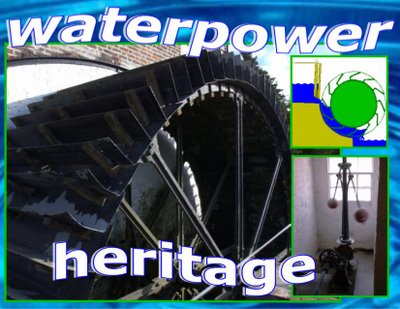
Intermediate Technology at its best!
The evolution of power technology and industrialisation begins with the early
hand devices, for example 'querns', which developed into more sophisticated devices such as the
human treadmills, all labour saving inventions.
It wasn't long before taming of animals took over, training them to turn the simple machines for agriculture and rudimentary manufacturing. These were basic
animal-powered mills.
Some time later, no body knows exactly when, harnessing the power of the flowing stream or river began. There are signs of simple
waterwheel technologies over 2,000 years ago in cultures across the planet, including remote parts of China, ancient Egypt, the Tibetan Himalayas, the Andes, and more.
This was the one of the main power sources used for over two millennia. The revolution was probably as significant then as the 'invention' of the computer or the internet is today. The windmill is a much later addition to our familiar landscape. Generally, the harnessing of wind power (other than for sailing) took place more in medieval times and so is relatively new technology.
In my view, the industrial revolution was not 100 years ago, for that was just the very short lived steam revolution. The real industrial revolution is that of the vertical waterwheel.
Waterpowered mills were not just for grinding corn to make flour. Waterpowered manufacturing processes were developed for almost every kind of product in everyday use through the ages. In the UK we still have working watermills for
weaving, flint grinding, china clay, grinding cutlery and tools, silk printing, cotton, needle making, snuff grinding, starch, mustard and washing blue, weaving, woolen fulling, wood turning, of course
paper making, beer production, gunpowder (though many used to explode, so there's not too many around),
hammer forge, oil manufacture, cider press, screws and nail making, putty, flax, leather cutting, tanning, ore crushing, sawing, agricultural machinery, and
paint making. I can give you examples of where to find all these.
At the Mill, we have some books and resources. You can always check out
S.P.A.B. (let me know if there's a hitch or to find out more).
For 2,000 years people experimented with the vertical waterwheel in all kinds of ways seeking optimum efficiency. Basically, they fit into four types:
overshot,
undershot,
breastshot and
backpitch. Some deciding factors of which type to build where depended on a number of key things, the volume of water, the speed of the flowing water, the gradient in the landscape (or not). Each type had an appropriate application depending whether the intention was to take power from the great swell of the tide or the rush of a small mountain stream, a large flowing river or a still millpond.
In the diagram here, you'll see that Crabble is breastshot because the water meets the waterwheel at it's midpoint and, consequently it rotates anticlockwise. Our wheel is fed by both the small river and the millpond. The pond is like the equivalent to the reserve petrol tank of fuel to drive a car engine.
Our vertical waterwheel is not the original to Crabble, but was added as technology advanced in the mid 1800's. It was state-of-the-art. It had an integral governor set to regulate the speed of the wheel. We understand this to be
the only one of it's type to still be in existence. We still use it for our milling today.
There are three sets of governors, two sets to regulate the millstones turning, and the one set to regulate the speed of the waterwheel itself
automatically. Therefore, the milling production was the finest that could be achieved with vertical waterwheel technology.
The reason Crabble Mill stopped working commercially in 1893 was simply that new technology took over. The next race commenced rather like 'MSN' and 'Google' for today's internet.
In flour milling by the 1900's waterturbines and steampower were the booming technologies. Rollermills took over from millstones for commercial use and remain so to this day even though they produce an inferior product. They produce large volumes quickly by crushing and smashing the grain into flour, where as millstones do not crush the gain. At Crabble the grain is cut thousands of times as it enters the central 'eye' of the stone and works it's way journeying through to the perimeter edge of the stone. Therefore the integrity of the grain product is still very much intact and it makes for a much more wholesome flour with
"now't taken out!".
Nowerdays, we call the kind of mechanisms in Crabble Mill intermediate technology. And, it's not a thing of the past. In many parts of world intermediate technology is being deployed to help resolve some of the very real life and death situations in, for example parts of Africa. They're not building these devices and machine systems just because they are poor, they're doing it because it helps them become more self-sufficient.
(I support the work of Practical Action and would like to do more to help their work. Check the link.)Long live the waterwheel revolution and our waterpower heritage!






